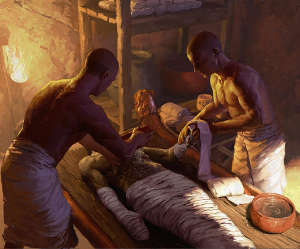Using AI to control energy for indoor agriculture
30 September 2024
Published online 3 February 2023
A new study sheds light on chemicals used in the ancient Egyptian embalming process, and reveals intricate trade networks between Egypt and tropical Africa and Asia.

© Nikola Nevenov
The study is the first to analyse materials from vessels recovered from a mummification workshop and its adjacent burial chambers. Previous studies had either attempted to learn what the materials might be from the relevant scriptures or analyzed them from mummies, but were not able to confirm their names or link the scripts to actual substances.
Researchers from Ludwig Maximilian University of Munich and the University of Tübingen in Germany collaborated with the National Research Center in Egypt to analyze chemical residues from 31 vessels found in an ancient Egyptian mummification workshop and four vessels from the adjacent burial chambers in Saqqara, dating back to the 26th Dynasty, which were excavated in 2016. Until then, scientists only knew from ancient scribblings the hieroglyphic names of the substances used in the embalming process, like antiu and sefet, but were not sure what these compound mixtures or substances are, nor the specific substances used for different parts of the body.
The molecular analyses revealed the use of antibacterial materials like beeswax; animal fat; plant oils like cypress, cedar and juniper; and resins like pistachios. Pistachio resin and castor oils were used exclusively for the head, along with juniper and cypress oil, animal fat and beeswax. The scientists also found that rainforest tree and plant resins, dammar and elemi, were used in the embalming process, and determined the various mixtures used for embalming specific body parts. Unlike previous understanding, bitumen and beeswax were not found in the balms used for bandages. Bitumen was also probably not used as much as previously thought, as it was only found in the burial chamber vessels, signifying its main use for anointing funerary objects.
The findings also revealed that antiu is not myrrh or frankincense as the name had been translated, but rather a mix of cedar and cypress oils, juniper and animal fats. “Now, Egyptologists are forced to go back to their texts and see if our identification of antiu as a specific mixture requests a new reading of previously translated texts,” says study co-author and prehistoric archaeologist, Philipp Stockhammer, of Ludwig Maximilian University of Munich.
One of the most significant findings was the use of substances imported from far flung regions, like dammar and elemi from southeast Asia or tropical Africa, resins from the Levant, and bitumen from the Dead Sea. The finding reveals that trade routes were more intricate during that period than previously thought.
The analysis of the vessels, dating back to 664-525 BC, demonstrates the embalmers’ intricate chemical knowledge and abilities to combine different substances, including ones imported from distant places, to obtain optimal results.
“The study fills large gaps in our understanding of embalming materials used in the 26th Dynasty, and is particularly rewarding, as we have the materials, their names, the pots in which they were placed, some directions as to their use, and the mummies upon which they were used,” says Salima Ikram, who is the head of the Egyptology unit at the American University in Cairo, who was not involved in the study. “This is a rare moment of synergy.”
Neal Woodman, a research zoologist with the U.S. Geological Survey and the U.S. National Museum of Natural History who has previously published work on animal mummies, said the findings help to reveal the complexity of the process and life back then. “This work directly links the components of the mixtures to an extensive trade network. The study helps one envision the level of sophistication of certain aspects of ancient Egyptian societies, as well as the impact of their religious practices on the global economy at that time,” says Woodman, who was not involved in the study. That level of connectivity and trade networks was previously unthought of.
doi:10.1038/nmiddleeast.2023.11
Rageot, M. et al. Biomolecular analyses enable new insights into ancient Egyptian embalming. Nature https://doi.org/10.1038/s41586-022-05663-4 (2022).
Stay connected: